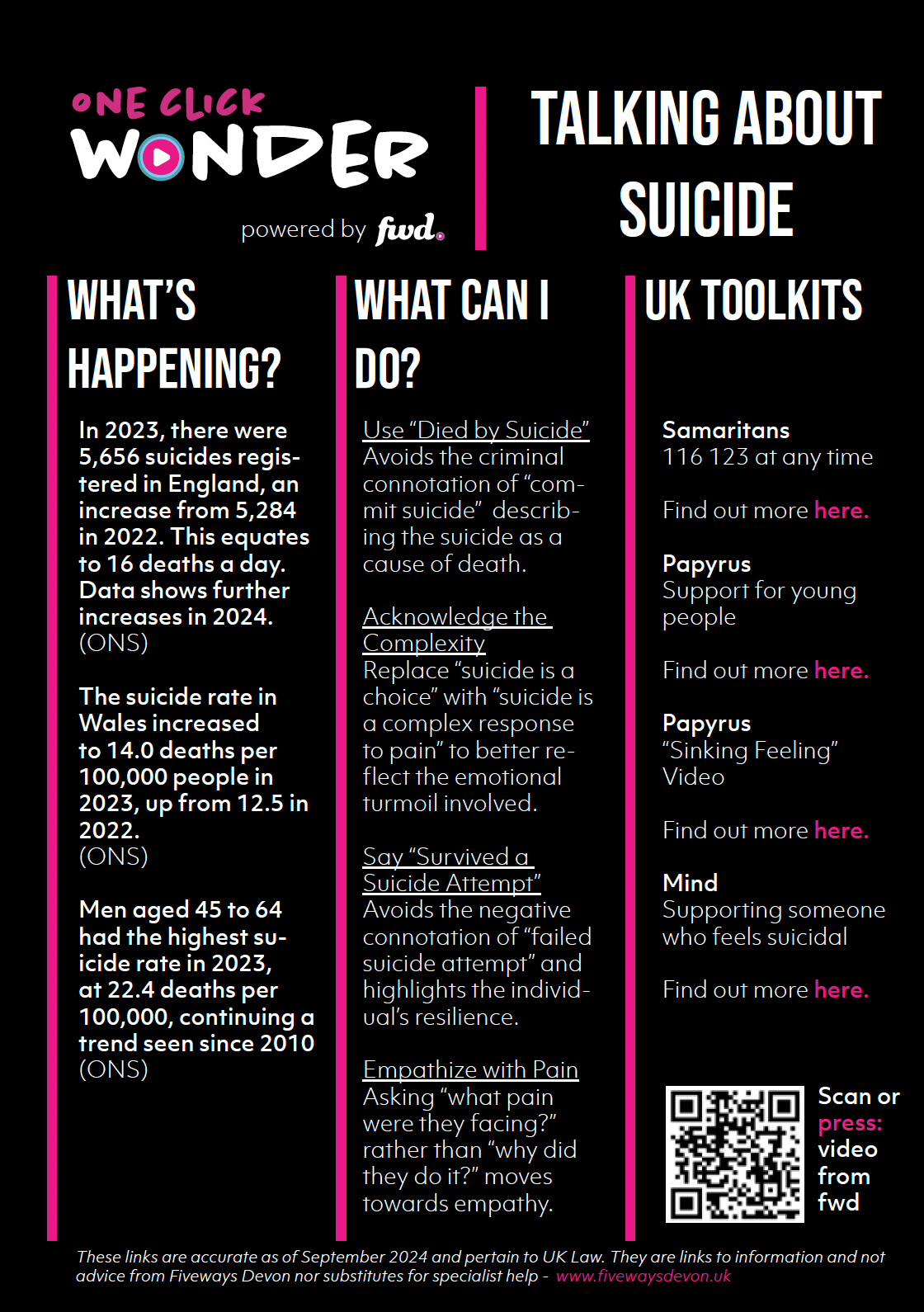- Mental Health Micro Guides (by fwd)
- Posts
- FREE Mental Health Micro Guide #10
FREE Mental Health Micro Guide #10
Talking well about suicide

Let’s get 1 million people trained by 2035
In this Mental Health Micro guide:
Welcome!
This issue is about talking constructively about suicide.
No details, news stories or methodology are included so you decide whether you want to read this now, later or not at all.
This issue also helps you prepare for Suicide Prevention Day in September.
Need help now?
(UK) Call The Samaritans on 116 123 or look at their website here
The Question: How do we talk well about suicide?
Suicide is an important topic to talk about well.
But we tend to avoid talking about it altogether.
We’re afraid of saying the wrong things.
So let’s start there…
(fwd is aiming to have all video content accompanied with a descriptive transcript so that we can benefit from the wisdom and character of all who engage. The descriptive transcript can be found under the video in Youtube.)
The Time-Saver: Talking about suicide
Save time with this One Click Wonder, all the key resources in one place - just one click away.
Open and save your own pdf version to keep and to share around the office - link under the image.
QR Code. You can either scan the QR Code or click the word “press” next to it to access the video above. Another way to share help and support.
This is part of a series. Interested in versions you can print without emptying the printer cartridge? Or interested in versions with your company logo on? Get in touch.
The Checklist: 4 Ways to Change the Language around Suicide
Four ‘why’s” and their '“how’s”. All to improve the conversation.
Here’s a summary from the video above.
How | Why |
|---|---|
Use "Died by Suicide" | This phrase avoids the criminal connotation of "commit suicide" and respects the person’s suffering. |
Acknowledge the Complexity | Replace "suicide is a choice" with "suicide is a complex response to pain" to reflect the deep emotional turmoil involved. |
Say "Survived a Suicide Attempt" | This phrase avoids the negative connotation of "failed suicide attempt" and highlights the individual’s resilience. |
Empathize with Pain | Asking "what pain were they facing?" shifts the focus from judgment to understanding and empathy. |
Suicide, it can be hard to talk about.
But talking about it can save a life.
So let’s find the right words
and LISTEN.
The Pause Portal: Reflecting on Control
What is in your control?
It is important to reflect on this.
If we put things in the box
marked “out of my control”
when they are actually
in our control
then we can become
fatalistic and
quick to blame.
If we put things in the box
marked “in my control”
when they are actually
out of our control
then we can become
burnt out as we
max out our headspace
or “cognitive load”.
This reflection is to help us discern
something that we need to let go of
because it is not in our control.
IMPORTANT: this exercise is not saying
we should put up with situations
like racism, injustice or abuse.
These are never acceptable
and are never
“just the view from here.”
Notice your breathe as you
look at this wooden archway
in Haldon Forest, Devon UK.
Notice the birdsong,
blackbirds, wrens and robins.
Notice the water flowing
and the constant sound it makes.
The archway is fixed.
But the view through it is not.
Seasons
Weather
Day
Night
Stillness
Wind
Wildlife
Birdsong
Budding
Blooming
Trickling
Flooding
None of these things are purposefully
good or bad.
They’re just the view from here.
Think of one thing
that comes to mind
that is beyond your control and influence
but that you have been
trying to control and influence.
Open your hand to
let this one thing go.
And send it through the archway.
it is just the view from here.
Try it and see what difference it makes
(fwd is aiming to have all video content accompanied with a descriptive transcript so that we can benefit from the wisdom and character of all who engage. The descriptive transcript can be found under the video in Youtube.)
Getting involved
Did someone forward this to you?
Jump on board here.
I would love to know what you thought of this Micro Guide.
Or have suggestions for future topics.
I regularly have discussions with people who want particular topics for their staff or volunteers and who want to use the videos and “One Click Wonders” to support their people’s wellbeing.
Join the conversation.
Press the “Get in Touch” button on the website.
That’s all for this week.
Until next week, let’s keep moving fwd…

